大学英语教学指南(教育部最新版)
《大学英语》学习指南
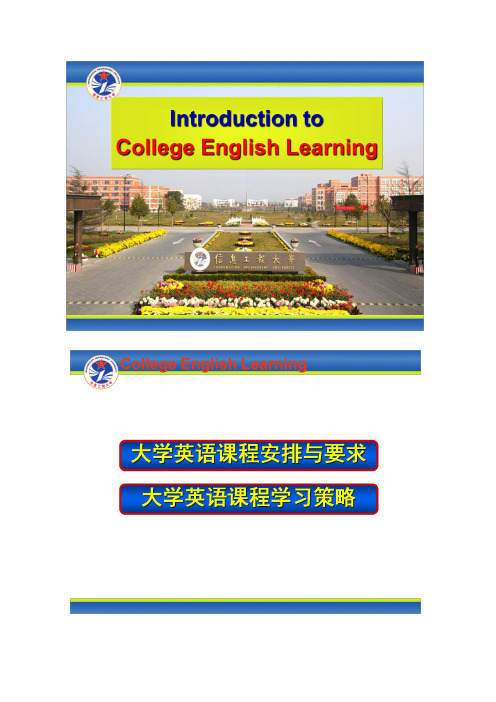
《大学英语》课程的教学目标是帮助学员打下较扎实的语言基础,掌握良好的语言学习方法,增强自主学习能力,提高综合文化素养,使他们具有较强的英语综合应用能力,特别是听说能力,能用英语有效地进行口头和书面的信息交流,以适应社会发展、经济建设和国际交流的需要。
我校的《大学英语》课程在达到教育部《课程要求》所规定教学目标的同时,还应瞄准部队任职岗位需要,着眼于学员的长远发展,提高学员自主学习能力和创新能力,打下一定的军事英语语言基础,能在对外军事交流与合作中发挥自身优势,成为复合型、高素质的军事人才,满足军队信息化建设的需要以及打赢现代高技术条件下局部战争的需要。
《大学英语课程教学要求课程要求》规定的大学阶段的英语教学要求《课程要求》的一般要求如下:1. 听力理解能力:能听懂英语授课,能听懂日常英语谈话、一般性题材讲座和语速为每分钟130—150词的英语国家慢速英语节目,掌握其中心大意,抓住要点和有关细节,领会讲话者的观点和态度。
能运用基本的听力技巧帮助理解。
2.口语表达能力:能在学习过程中较流利地进行英语交流,并就某一主题进行讨论;能就日常话题和来自讲英语国家的人士进行交流;能就所熟悉的话题经准备后作5—10分钟的简短发言,表达思想比较清楚,语言、语调基本正确;能在会话中使用基本的会话策略。
3.阅读理解能力:能读懂难度中等的一般性题材的英语文章和应用文体材料,能基本读懂国内英文报刊和英语国家报刊杂志上一般性题材的文章,掌握中心大意,抓住主要事实和有关细节,能在阅读中使用有效的阅读方法;阅读速度达到每分钟70词,在快速阅读篇章较长、难度略低的材料时,阅读速度达到每分钟100词。
4.书面表达能力:能用常见的各种应用文体完成一般的写作任务,能较好地描述个人经历、事件、观感、情感等;能就一定话题或提纲在半小时内写出120—150词的短文,内容完整、用词恰当、语篇连贯,表达意思清楚,无重大语言错误,并能使用恰当的写作技能。
(完整版)大学英语教学指南(教育部2017最新版)
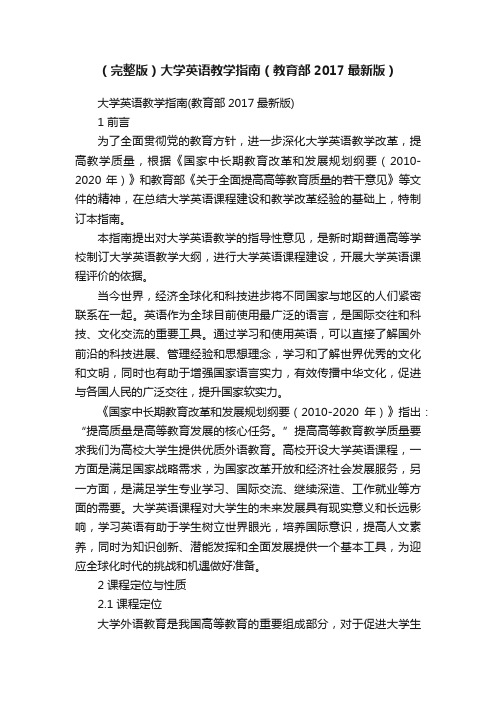
(完整版)大学英语教学指南(教育部2017最新版)大学英语教学指南(教育部2017最新版)1 前言为了全面贯彻党的教育方针,进一步深化大学英语教学改革,提高教学质量,根据《国家中长期教育改革和发展规划纲要(2010-2020年)》和教育部《关于全面提高高等教育质量的若干意见》等文件的精神,在总结大学英语课程建设和教学改革经验的基础上,特制订本指南。
本指南提出对大学英语教学的指导性意见,是新时期普通高等学校制订大学英语教学大纲,进行大学英语课程建设,开展大学英语课程评价的依据。
当今世界,经济全球化和科技进步将不同国家与地区的人们紧密联系在一起。
英语作为全球目前使用最广泛的语言,是国际交往和科技、文化交流的重要工具。
通过学习和使用英语,可以直接了解国外前沿的科技进展、管理经验和思想理念,学习和了解世界优秀的文化和文明,同时也有助于增强国家语言实力,有效传播中华文化,促进与各国人民的广泛交往,提升国家软实力。
《国家中长期教育改革和发展规划纲要(2010-2020年)》指出:“提高质量是高等教育发展的核心任务。
”提高高等教育教学质量要求我们为高校大学生提供优质外语教育。
高校开设大学英语课程,一方面是满足国家战略需求,为国家改革开放和经济社会发展服务,另一方面,是满足学生专业学习、国际交流、继续深造、工作就业等方面的需要。
大学英语课程对大学生的未来发展具有现实意义和长远影响,学习英语有助于学生树立世界眼光,培养国际意识,提高人文素养,同时为知识创新、潜能发挥和全面发展提供一个基本工具,为迎应全球化时代的挑战和机遇做好准备。
2 课程定位与性质2.1 课程定位大学外语教育是我国高等教育的重要组成部分,对于促进大学生知识、能力和综合素质的协调发展具有重要意义。
大学英语作为大学外语教育的最主要内容,是大多数非英语专业学生在本科教育阶段必修的公共基础课程,在人才培养方面具有不可替代的重要作用。
大学英语课程应根据本科专业类教学质量国家标准,参照本指南进行合理定位,服务于学校的办学目标、院系人才培养的目标和学生个性化发展的需求。
高等教育大学英语教学大纲(最新)

高等教育大学英语教学大纲(最新)高等教育大学英语教学大纲《大学英语课程教学要求》是2007年8月14日由教育部发布的关于大学英语教学的教学基本要求。
本大纲是各高等学校根据教育部《大学英语课程教学要求》和本校的实际情况,制订的适合本校的大学英语教学大纲。
本大纲适用于实施大学英语教学的高等学校。
大学英语教学是高等教育的一个有机组成部分,大学英语课程是大学生的一门必修的公共基础课程。
本教学大纲(包括指导思想、课程目标、教学要求、课程设置、教学实施和课程评估)依据《大学英语课程教学要求》而制订。
大学英语初级教学大纲《大学英语》是一门针对文理科大学所有学生开设的综合性英语教育课程。
本课程的教学目标是帮助学生掌握英语的基本知识和基本技能,培养学生在各类环境中的英语应用能力。
具体而言,本课程的教学内容将包括语言知识、语言技能、语言文化等方面的知识,旨在帮助学生掌握基本的英语语法、词汇、听说读写等方面的技能,以及培养学生的英语思维能力、跨文化交际能力、自主学习能力等综合素质。
《大学英语》的教学大纲分为两个学期,每学期16周,每周4学时。
第一学期的教学内容主要包括:精读课文4篇、泛读课文4篇、听力训练10次、口语训练10次、写作训练10次等。
第二学期的教学内容与第一学期类似。
在教学评估方面,本课程将采用形成性评估和终结性评估相结合的方式。
形成性评估包括课堂表现、作业、测验、口语测试等,占总评分的60%;终结性评估包括期末考试和口语测试等,占总评分的40%。
农业类大学英语教学大纲农业类大学英语教学大纲应包括以下内容:1.课程基本信息:包括课程名称、课程代码、授课学期、授课对象、学时安排、学分以及教学目标等。
2.课程性质:说明本课程在专业培养计划中的地位和作用,以及与其他课程的联系。
3.教学内容与要求:根据《大学英语教学指南》的精神,结合专业特点,对农业类专业的英语教学提出具体的教学要求。
4.教学内容与学时安排:根据语言技能、语言知识、文化知识、情感态度、学习策略等方面的目标,结合专业特点,设计每项教学内容,并根据教学内容的需要,合理安排学时。
(完整版)大学英语教学指南(教育部2017最新版)
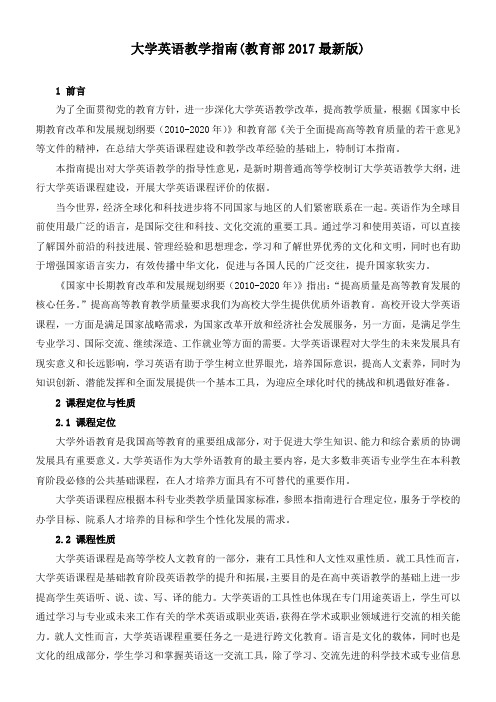
大学英语教学指南(教育部2017最新版)1 前言为了全面贯彻党的教育方针,进一步深化大学英语教学改革,提高教学质量,根据《国家中长期教育改革和发展规划纲要(2010-2020年)》和教育部《关于全面提高高等教育质量的若干意见》等文件的精神,在总结大学英语课程建设和教学改革经验的基础上,特制订本指南。
本指南提出对大学英语教学的指导性意见,是新时期普通高等学校制订大学英语教学大纲,进行大学英语课程建设,开展大学英语课程评价的依据。
当今世界,经济全球化和科技进步将不同国家与地区的人们紧密联系在一起。
英语作为全球目前使用最广泛的语言,是国际交往和科技、文化交流的重要工具。
通过学习和使用英语,可以直接了解国外前沿的科技进展、管理经验和思想理念,学习和了解世界优秀的文化和文明,同时也有助于增强国家语言实力,有效传播中华文化,促进与各国人民的广泛交往,提升国家软实力。
《国家中长期教育改革和发展规划纲要(2010-2020年)》指出:“提高质量是高等教育发展的核心任务。
”提高高等教育教学质量要求我们为高校大学生提供优质外语教育。
高校开设大学英语课程,一方面是满足国家战略需求,为国家改革开放和经济社会发展服务,另一方面,是满足学生专业学习、国际交流、继续深造、工作就业等方面的需要。
大学英语课程对大学生的未来发展具有现实意义和长远影响,学习英语有助于学生树立世界眼光,培养国际意识,提高人文素养,同时为知识创新、潜能发挥和全面发展提供一个基本工具,为迎应全球化时代的挑战和机遇做好准备。
2 课程定位与性质2.1 课程定位大学外语教育是我国高等教育的重要组成部分,对于促进大学生知识、能力和综合素质的协调发展具有重要意义。
大学英语作为大学外语教育的最主要内容,是大多数非英语专业学生在本科教育阶段必修的公共基础课程,在人才培养方面具有不可替代的重要作用。
大学英语课程应根据本科专业类教学质量国家标准,参照本指南进行合理定位,服务于学校的办学目标、院系人才培养的目标和学生个性化发展的需求。
大学英语教学指南2020 教育部
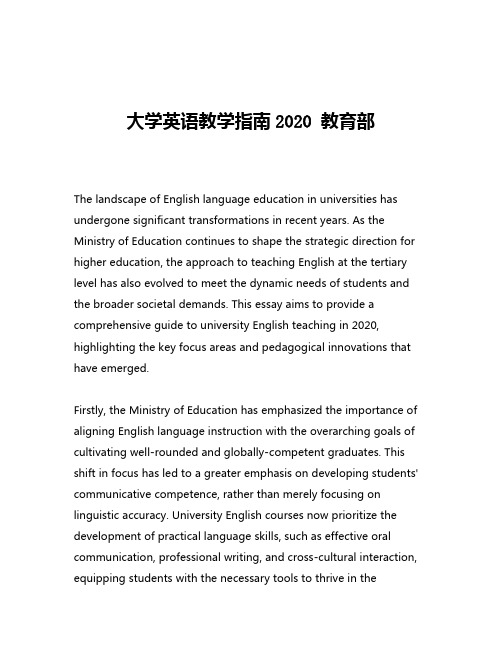
大学英语教学指南2020 教育部The landscape of English language education in universities has undergone significant transformations in recent years. As the Ministry of Education continues to shape the strategic direction for higher education, the approach to teaching English at the tertiary level has also evolved to meet the dynamic needs of students and the broader societal demands. This essay aims to provide a comprehensive guide to university English teaching in 2020, highlighting the key focus areas and pedagogical innovations that have emerged.Firstly, the Ministry of Education has emphasized the importance of aligning English language instruction with the overarching goals of cultivating well-rounded and globally-competent graduates. This shift in focus has led to a greater emphasis on developing students' communicative competence, rather than merely focusing on linguistic accuracy. University English courses now prioritize the development of practical language skills, such as effective oral communication, professional writing, and cross-cultural interaction, equipping students with the necessary tools to thrive in theincreasingly interconnected world.To achieve this, universities have adopted a more learner-centered approach to English language teaching. The traditional lecture-based model has given way to interactive classroom activities, collaborative learning, and project-based assignments. Instructors are encouraged to create dynamic learning environments that foster active student engagement, critical thinking, and problem-solving skills. This approach not only enhances language proficiency but also nurtures the broader cognitive and interpersonal abilities that are highly valued in the job market.Another key aspect of the Ministry of Education's guidance for university English teaching is the integration of technology-enhanced learning. The rapid advancements in digital technologies have transformed the way language is taught and learned. Universities are now embracing a blended learning approach, which combines face-to-face instruction with online and multimedia resources. This integration of technology allows for more personalized learning experiences, increased access to authentic language materials, and the development of digital literacy skills – all of which are crucial for success in the 21st-century workplace.Furthermore, the Ministry of Education has emphasized the importance of incorporating intercultural communication and globalawareness into the English language curriculum. Given the increasingly diverse and interconnected nature of the world, it is essential for university students to develop a deep understanding of cultural differences, sensitivity, and the ability to navigate cross-cultural interactions effectively. English language courses now incorporate elements of cultural studies, comparative analyses, and opportunities for international exchange or virtual collaboration, enabling students to broaden their perspectives and enhance their intercultural competence.In addition to these overarching pedagogical shifts, the Ministry of Education has also highlighted the need for continuous professional development for English language instructors. University faculty are encouraged to engage in ongoing training, research, and collaboration to stay abreast of the latest teaching methodologies, technological advancements, and emerging trends in the field of English language education. This investment in faculty development not only ensures the delivery of high-quality instruction but also fosters a culture of innovation and lifelong learning within the university community.Moreover, the Ministry of Education has emphasized the importance of aligning university English language programs with industry needs and employability outcomes. By collaborating with key stakeholders, such as employers, professional organizations, and industry experts,universities can design English language curricula that are responsive to the evolving demands of the job market. This approach enables students to develop the specific language and communication skills required for their chosen career paths, enhancing their employability and facilitating a smooth transition from academia to the workforce.Finally, the Ministry of Education has recognized the need for a more comprehensive and holistic assessment of student learning in university English language programs. Traditional examinations and tests are being complemented by a diverse range of assessment methods, including portfolio-based evaluations, project presentations, and peer-to-peer assessments. This shift towards a more authentic and multidimensional assessment approach aims to provide a more accurate and comprehensive evaluation of students' language proficiency, critical thinking, and overall academic and professional readiness.In conclusion, the Ministry of Education's guidance for university English teaching in 2020 reflects a strategic shift towards a more learner-centered, technology-driven, and globally-oriented approach to language education. By emphasizing the development of practical communication skills, intercultural competence, and industry-relevant learning outcomes, universities are better equipped to prepare their students for the challenges and opportunities of the 21st-century global landscape. As the education landscape continuesto evolve, the implementation of these guiding principles will be crucial in ensuring the ongoing relevance and effectiveness of university English language programs in China.。
新修订《大学英语教学指南》对地方院校校本课程建设的启示

118科技资讯 SCIENCE & TECHNOLOGY INFORMATION科 技 教 育DOI:10.16661/ki.1672-3791.2101-5042-5598新修订《大学英语教学指南》对地方院校校本课程建设的启示王坤邦(滇西科技师范学院外国语学院 云南临沧 677000)摘 要:为适应新时代中国高等教育的改革与发展需求,《大学英语教学指南》在原有基础上进行了修订。
继承了前一版的大学英语课程性质兼具工具性和人文性,大学英语课程目标分为基础、提高、发展这3个级别,大学英语课程设置包括通用英语、专门用途英语、跨文化交际这三类课程的主要内容。
该文对《指南》做了简介,阐述了新修订的几个主要方面,地方院校将以新修订《指南》为蓝本实现对校本课程的分类教学,从而提升大学英语的教学质量。
关键词:新修订 大学英语 教学指南 校本课程中图分类号:G64 文献标识码:A文章编号:1672-3791(2021)07(c)-0118-03The Enlightenment of the Newly-revised College English Teaching Guidelines on the Construction of the School-based Curriculum in Local Colleges and UniversitiesWANG Kunbang(School of Foreign Languages, West Yunnan University, Lincang, Yunnan Province, 677000 China)Abstract: In order to meet the needs of the reform and development of China's higher education in the new era, the College English Teaching Guidelines has been revised on the original basis. Inheriting the previous version of the college English curriculum, which is both instrumental and humanistic. The college English curriculum objectives are divided into three levels: foundation, improvement, and development. The college English curriculum includes three main contents: general English, English for special purposes and cross-cultural communication. This paper makes a brief introduction to the Guide and expounds several main aspects of the new revision. Local colleges and universities will take the newly revised Guide as the blueprint to realize the classif ied teaching of school-based courses, so as to improve the quality of college English teaching.Key Words: Newly-revised; College English; Teaching guidelines; School-based curriculum作者简介:王坤邦(1979—),男,硕士,副教授,研究方向为社会语言学、应用语言学及少数民族外语教育。
大学英语教学指南
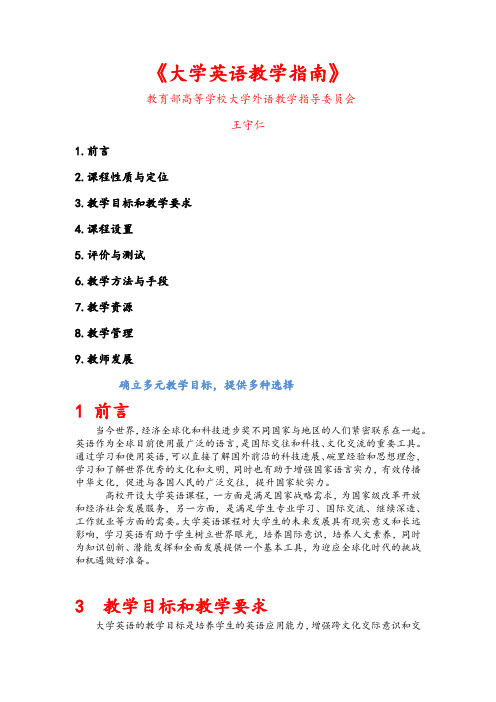
《大学英语教学指南》教育部高等学校大学外语教学指导委员会王守仁1.前言2.课程性质与定位3.教学目标和教学要求4.课程设置5.评价与测试6.教学方法与手段7.教学资源8.教学管理9.教师发展确立多元教学目标,提供多种选择1 前言当今世界,经济全球化和科技进步奖不同国家与地区的人们紧密联系在一起。
英语作为全球目前使用最广泛的语言,是国际交往和科技、文化交流的重要工具。
通过学习和使用英语,可以直接了解国外前沿的科技进展、碗里经验和思想理念,学习和了解世界优秀的文化和文明,同时也有助于增强国家语言实力,有效传播中华文化,促进与各国人民的广泛交往,提升国家软实力。
高校开设大学英语课程,一方面是满足国家战略需求,为国家级改革开放和经济社会发展服务,另一方面,是满足学生专业学习、国际交流、继续深造、工作就业等方面的需要。
大学英语课程对大学生的未来发展具有现实意义和长远影响,学习英语有助于学生树立世界眼光,培养国际意识,培养人文素养,同时为知识创新、潜能发挥和全面发展提供一个基本工具,为迎应全球化时代的挑战和机遇做好准备。
3教学目标和教学要求大学英语的教学目标是培养学生的英语应用能力,增强跨文化交际意识和交际能力,同时发展自主学习能力,提高综合文化素养,是他们在学习、生活、社会交往和未来工作中能够有效地使用英语,满足国家、社会、学校和个人发展的需要。
基础目标提高目标发展目标大学英语根据三级教学目标目标提出三个级别的教学要求。
基础目标的教学要求主要针对英语高考成绩合格的学生,是大部分学生本科毕业时应达到的基本要求。
提高目标和发展目标的教学要求分别针对大学入学时应予以达到较好水平的学生,也是对学生英语应用能力要求较高的专业所选择的要求。
对英语高考成绩基本合格的学生学校可适当调整基础目标的部分教学要求。
基础目标能够基本满足日常生活、学习和未来工作中与自身密切相关的信息交流的需要;能够基本正确地运用英语语言、智慧、语法及篇章结构等语言知识,在高中阶段应掌握的词汇基础上增加约2000个单词,其中四百个单词为与专业学习与未来工作相关的词汇;能够基本理解语言难度中等、设计常见的个人和社会交流题材的口头或书面材料;能够就熟悉的主题或话题进行简单的口头和书面交流;能够借助网络资源、工具书或他人的帮助,对中等语言难度的信息进行处理和加工,理解主旨思想和重要细节,表达基本打一份好能够使用有限的学习策略;在与来自不同文化的人交流时,能够观察到彼此之间的文化和价值观差异,并能根据交际需求运用有限的交际策略。
(完整版)大学英语教学指南(教育部2017最新版)

大学英语教学指南(教育部2017最新版)1 前言为了全面贯彻党的教育方针,进一步深化大学英语教学改革,提高教学质量,根据《国家中长期教育改革和发展规划纲要(2010-2020年)》和教育部《关于全面提高高等教育质量的若干意见》等文件的精神,在总结大学英语课程建设和教学改革经验的基础上,特制订本指南。
本指南提出对大学英语教学的指导性意见,是新时期普通高等学校制订大学英语教学大纲,进行大学英语课程建设,开展大学英语课程评价的依据。
当今世界,经济全球化和科技进步将不同国家与地区的人们紧密联系在一起。
英语作为全球目前使用最广泛的语言,是国际交往和科技、文化交流的重要工具。
通过学习和使用英语,可以直接了解国外前沿的科技进展、管理经验和思想理念,学习和了解世界优秀的文化和文明,同时也有助于增强国家语言实力,有效传播中华文化,促进与各国人民的广泛交往,提升国家软实力。
《国家中长期教育改革和发展规划纲要(2010-2020年)》指出:“提高质量是高等教育发展的核心任务。
”提高高等教育教学质量要求我们为高校大学生提供优质外语教育。
高校开设大学英语课程,一方面是满足国家战略需求,为国家改革开放和经济社会发展服务,另一方面,是满足学生专业学习、国际交流、继续深造、工作就业等方面的需要。
大学英语课程对大学生的未来发展具有现实意义和长远影响,学习英语有助于学生树立世界眼光,培养国际意识,提高人文素养,同时为知识创新、潜能发挥和全面发展提供一个基本工具,为迎应全球化时代的挑战和机遇做好准备。
2 课程定位与性质2.1 课程定位大学外语教育是我国高等教育的重要组成部分,对于促进大学生知识、能力和综合素质的协调发展具有重要意义。
大学英语作为大学外语教育的最主要内容,是大多数非英语专业学生在本科教育阶段必修的公共基础课程,在人才培养方面具有不可替代的重要作用。
大学英语课程应根据本科专业类教学质量国家标准,参照本指南进行合理定位,服务于学校的办学目标、院系人才培养的目标和学生个性化发展的需求。
大学英语教学的指南(教育部最新版)
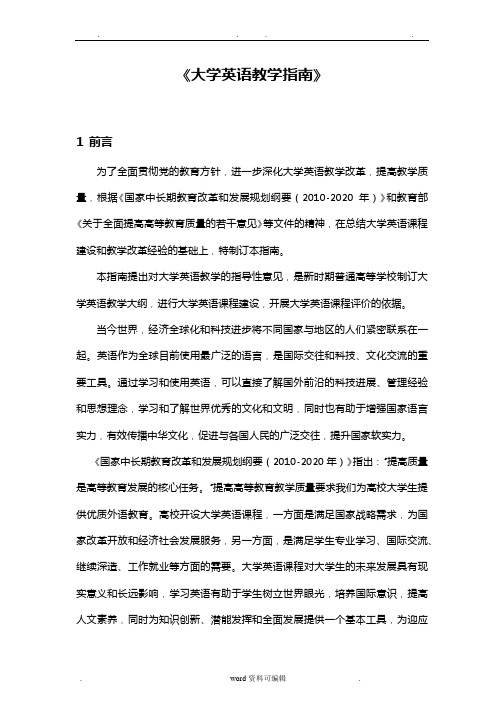
《大学英语教学指南》1 前言为了全面贯彻党的教育方针,进一步深化大学英语教学改革,提高教学质量,根据《国家中长期教育改革和发展规划纲要(2010-2020年)》和教育部《关于全面提高高等教育质量的若干意见》等文件的精神,在总结大学英语课程建设和教学改革经验的基础上,特制订本指南。
本指南提出对大学英语教学的指导性意见,是新时期普通高等学校制订大学英语教学大纲,进行大学英语课程建设,开展大学英语课程评价的依据。
当今世界,经济全球化和科技进步将不同国家与地区的人们紧密联系在一起。
英语作为全球目前使用最广泛的语言,是国际交往和科技、文化交流的重要工具。
通过学习和使用英语,可以直接了解国外前沿的科技进展、管理经验和思想理念,学习和了解世界优秀的文化和文明,同时也有助于增强国家语言实力,有效传播中华文化,促进与各国人民的广泛交往,提升国家软实力。
《国家中长期教育改革和发展规划纲要(2010-2020年)》指出:“提高质量是高等教育发展的核心任务。
”提高高等教育教学质量要求我们为高校大学生提供优质外语教育。
高校开设大学英语课程,一方面是满足国家战略需求,为国家改革开放和经济社会发展服务,另一方面,是满足学生专业学习、国际交流、继续深造、工作就业等方面的需要。
大学英语课程对大学生的未来发展具有现实意义和长远影响,学习英语有助于学生树立世界眼光,培养国际意识,提高人文素养,同时为知识创新、潜能发挥和全面发展提供一个基本工具,为迎应全球化时代的挑战和机遇做好准备。
2 课程定位与性质2.1 课程定位大学外语教育是我国高等教育的重要组成部分,对于促进大学生知识、能力和综合素质的协调发展具有重要意义。
大学英语作为大学外语教育的最主要内容,是大多数非英语专业学生在本科教育阶段必修的公共基础课程,在人才培养方面具有不可替代的重要作用。
大学英语课程应根据本科专业类教学质量国家标准,参照本指南进行合理定位,服务于学校的办学目标、院系人才培养的目标和学生个性化发展的需求。
大学英语教学指南教育部最新版3篇

大学英语教学指南教育部最新版
第一篇: 大学英语教学指南教育部最新版
随着全球化的进程,英语已经成为世界上最重要的一门语言,并且在现代社会中发挥着越来越重要的作用。
因此,在当今的教育体系中,英语教学也成为了一个非常重要的环节。
为了更好地提高大学生的英语水平,教育部颁布了最新版的大学英语教学指南。
这份指南重点关注了两个方面:一是大学英语教学的教学内容和方法,二是大学英语教学的评价标准。
在教学内容和方法方面,该指南主要强调了英语教学的实用性和交际性。
它提出了使用现代教育技术来提高教学效率的方法,并且建议采用多种教学方法和手段,如讲授、案例研究、讨论、演示、角色扮演等等,以更好地激发学生的兴趣和提高他们的学习效果。
此外,该指南还特别强调了听说读写的综合技能培养,指出了教师需要强调语音和语调的训练,同时还需注重词汇和语法的学习和应用。
在教材上也需要紧密结合实际场景编写,并增加文化背景和国际化元素,以便更好地促进学生的跨文化交际能力。
在评价标准方面,该指南提出了一系列评价标准,如学习目标、学业水平、语言水平、实用能力等,旨在更好地反映学生综合素质的提高和能力的实际运用。
此外,教学评价应该注重学生自主学习和合作学习的能力,适当借助现代化教育技术来实现教学效果的提高。
总之,这份最新版本的大学英语教学指南为教师们提供
了一个良好的教学参考和执行标准,同时它还鼓励教师们与同行进行交流,共同提高自己的教学水平和思维能力。
相信在这个指南的指导下,大学英语教学将会更为科学、高效、有益。
教育部2023大学英语教学指南
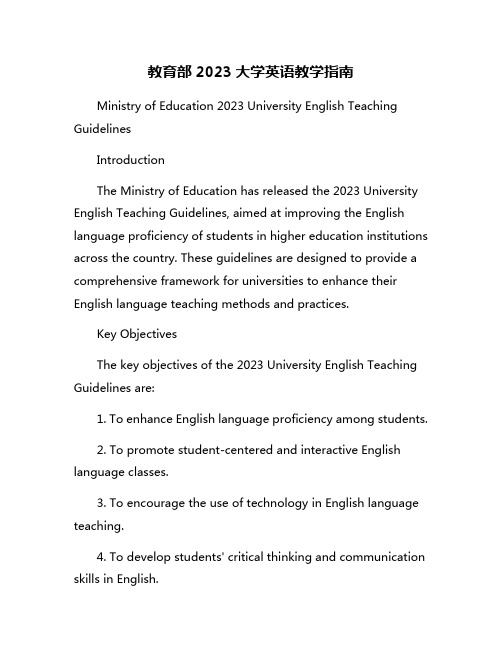
教育部2023大学英语教学指南Ministry of Education 2023 University English Teaching GuidelinesIntroductionThe Ministry of Education has released the 2023 University English Teaching Guidelines, aimed at improving the English language proficiency of students in higher education institutions across the country. These guidelines are designed to provide a comprehensive framework for universities to enhance their English language teaching methods and practices.Key ObjectivesThe key objectives of the 2023 University English Teaching Guidelines are:1. To enhance English language proficiency among students.2. To promote student-centered and interactive English language classes.3. To encourage the use of technology in English language teaching.4. To develop students' critical thinking and communication skills in English.5. To align English language teaching with international standards.Key ComponentsThe guidelines include the following key components:1. Curriculum Development: Universities are encouraged to design English language curricula that are comprehensive and aligned with the Common European Framework of Reference for Languages (CEFR). The curriculum should focus on all four language skills (reading, writing, listening, and speaking) and provide opportunities for students to practice these skills inreal-life contexts.2. Teaching Methodology: The guidelines emphasize the importance of student-centered and interactive teaching methods. Teachers are encouraged to use a variety of techniques, such as group work, pair work, role plays, and discussions, to engage students and enhance their learning experience.3. Assessment: Universities are advised to use a variety of assessment methods to evaluate students' English language proficiency. These may include exams, quizzes, presentations, projects, and portfolios. Assessment should be ongoing andformative, providing students with regular feedback on their progress.4. Professional Development: The guidelines recommend that universities provide professional development opportunities for English language teachers. This may include training workshops, seminars, conferences, and online courses to enhance teachers' knowledge and skills in English language teaching.5. Technology Integration: Universities are encouraged to integrate technology into English language teaching. This may include using online resources, multimedia tools, and virtual learning platforms to enhance students' learning experience and provide them with opportunities to practice English outside the classroom.ConclusionThe 2023 University English Teaching Guidelines provide a roadmap for universities to enhance their English language teaching methods and practices. By following these guidelines, universities can help students develop their English language proficiency, critical thinking, and communication skills, and prepare them to succeed in an increasingly globalized world. It is hoped that these guidelines will contribute to the overallimprovement of English language teaching in higher education institutions and ultimately benefit students in their academic and professional endeavors.。
大学英语教学指南(教育部最新版)
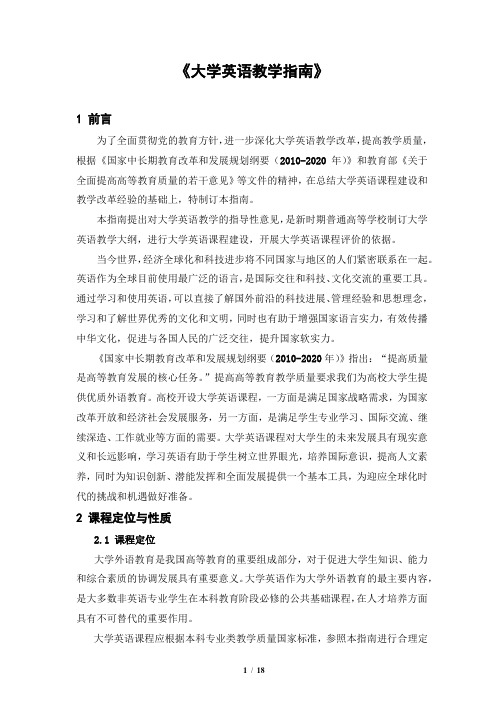
《大学英语教学指南》1 前言为了全面贯彻党的教育方针,进一步深化大学英语教学改革,提高教学质量,根据《国家中长期教育改革和发展规划纲要(2010-2020年)》和教育部《关于全面提高高等教育质量的若干意见》等文件的精神,在总结大学英语课程建设和教学改革经验的基础上,特制订本指南。
本指南提出对大学英语教学的指导性意见,是新时期普通高等学校制订大学英语教学大纲,进行大学英语课程建设,开展大学英语课程评价的依据。
当今世界,经济全球化和科技进步将不同国家与地区的人们紧密联系在一起。
英语作为全球目前使用最广泛的语言,是国际交往和科技、文化交流的重要工具。
通过学习和使用英语,可以直接了解国外前沿的科技进展、管理经验和思想理念,学习和了解世界优秀的文化和文明,同时也有助于增强国家语言实力,有效传播中华文化,促进与各国人民的广泛交往,提升国家软实力。
《国家中长期教育改革和发展规划纲要(2010-2020年)》指出:“提高质量是高等教育发展的核心任务。
”提高高等教育教学质量要求我们为高校大学生提供优质外语教育。
高校开设大学英语课程,一方面是满足国家战略需求,为国家改革开放和经济社会发展服务,另一方面,是满足学生专业学习、国际交流、继续深造、工作就业等方面的需要。
大学英语课程对大学生的未来发展具有现实意义和长远影响,学习英语有助于学生树立世界眼光,培养国际意识,提高人文素养,同时为知识创新、潜能发挥和全面发展提供一个基本工具,为迎应全球化时代的挑战和机遇做好准备。
2 课程定位与性质2.1 课程定位大学外语教育是我国高等教育的重要组成部分,对于促进大学生知识、能力和综合素质的协调发展具有重要意义。
大学英语作为大学外语教育的最主要内容,是大多数非英语专业学生在本科教育阶段必修的公共基础课程,在人才培养方面具有不可替代的重要作用。
大学英语课程应根据本科专业类教学质量国家标准,参照本指南进行合理定位,服务于学校的办学目标、院系人才培养的目标和学生个性化发展的需求。
大学英语教学指南教育部最新版

大学英语教学指南教育部最新版
大学英语教学指南是教育部出版的教学参考书,主要面
向大学英语教师及教育行政管理人员。
翻开这本教材,我们不仅可以了解大学英语课程的教学内容,还能从中获得教学策略、评估方法等方面的指导。
本指南主要包括两个部分,第一部分是大学英语课程标准,第二部分则是针对不同层次、不同类型的学生的课程设计和实施指南。
大学英语课程标准
大学英语课程标准分为四个等级:B1、B2、C1和C2。
每
个等级都明确了该等级学生应具备的英语能力水平及相应的目标、教学内容和要求。
在大学英语课程中,学生需要逐步提高听、说、读、写、译等方面的综合能力,并能在实际沟通中灵活地运用所学语言知识和技能。
同时,还需培养学生的跨文化交际能力,以更好地应对国际化交流和竞争。
此外,在大学英语课程中,教师还需注重培养学生的学
习策略和学习习惯,帮助学生构建有效的英语学习体系,并通过不同形式的学习和评估来促进学生的学业进步。
针对不同层次、不同类型的学生的课程设计和实施指南
在课程设计和实施方面,指南根据学生的英语水平及需要,提供了不同级别和专业领域的教学建议。
教师可根据自身教学经验和学生需求,灵活应用这些建议,制定个性化的课程设计和评估方案。
此外,指南强调教师需要重视学生的课外阅读、听力和
口语训练,以拓宽学生的视野,提高其英语综合运用能力。
总结
大学英语教学指南在理论与实践上结合,为大学英语教
师提供了全面的教学指导,帮助教师设计更加科学有效的课程、教学和评估方案。
它对英语教学的发展和提高起到了积极的推动作用,为我国大学英语教育的健康发展做出了宝贵的贡献。
中国高等教育大学英语专业本科教学指南
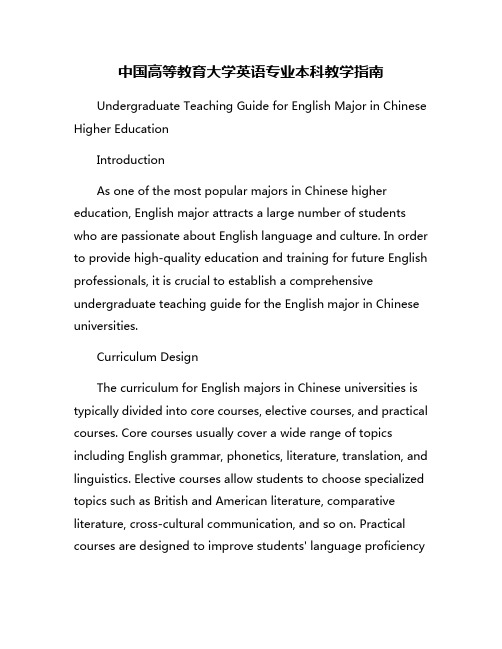
中国高等教育大学英语专业本科教学指南Undergraduate Teaching Guide for English Major in Chinese Higher EducationIntroductionAs one of the most popular majors in Chinese higher education, English major attracts a large number of students who are passionate about English language and culture. In order to provide high-quality education and training for future English professionals, it is crucial to establish a comprehensive undergraduate teaching guide for the English major in Chinese universities.Curriculum DesignThe curriculum for English majors in Chinese universities is typically divided into core courses, elective courses, and practical courses. Core courses usually cover a wide range of topics including English grammar, phonetics, literature, translation, and linguistics. Elective courses allow students to choose specialized topics such as British and American literature, comparative literature, cross-cultural communication, and so on. Practical courses are designed to improve students' language proficiencyand practical skills, including language practice, interpretation, translation, and writing.Teaching MethodsIn order to improve students' English proficiency and critical thinking skills, a variety of teaching methods should be employed in English major classes. These may include lectures, seminars, group discussions, presentations, debates, and project-based learning. It is also important to encourage students to participate in extracurricular activities such as English clubs, language exchange programs, and study abroad programs to further enhance their language skills and cultural awareness.AssessmentAssessment plays a crucial role in evaluating students' learning outcomes and progress. Assessment methods for English major courses may include written exams, oral exams, essays, research papers, presentations, and group projects. It is important to provide constructive feedback to students in order to help them improve their academic performance and achieve their learning goals.Career GuidanceIn addition to academic courses, career guidance and counseling should also be an integral part of the undergraduate teaching guide for English majors. Students should be provided with information about career opportunities in various fields such as education, translation, interpretation, publishing, journalism, tourism, and international trade. Workshops, internships, and networking opportunities should be organized to help students gain practical experience and build professional connections.ConclusionIn conclusion, the undergraduate teaching guide for English majors in Chinese higher education should focus on curriculum design, teaching methods, assessment, and career guidance. By providing a comprehensive and well-rounded education, we can cultivate well-rounded English professionals who are equipped with the language skills, critical thinking abilities, and cultural awareness needed to succeed in the globalized world.。
中国高等教育大学英语专业本科教学指南
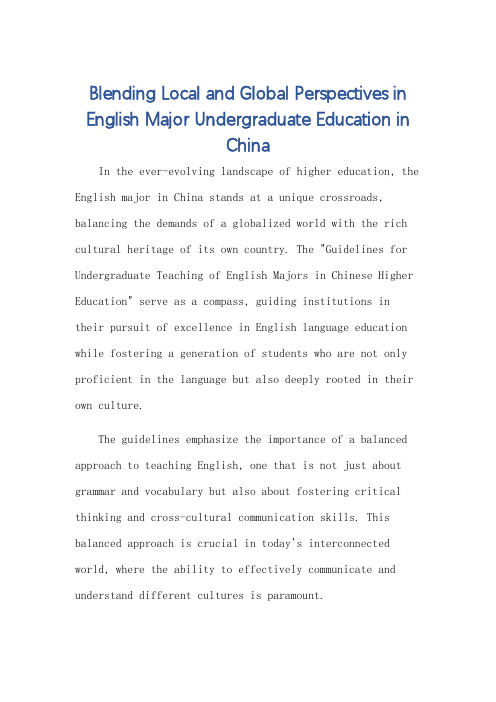
Blending Local and Global Perspectives in English Major Undergraduate Education inChinaIn the ever-evolving landscape of higher education, the English major in China stands at a unique crossroads, balancing the demands of a globalized world with the rich cultural heritage of its own country. The "Guidelines for Undergraduate Teaching of English Majors in Chinese Higher Education" serve as a compass, guiding institutions intheir pursuit of excellence in English language education while fostering a generation of students who are not only proficient in the language but also deeply rooted in their own culture.The guidelines emphasize the importance of a balanced approach to teaching English, one that is not just about grammar and vocabulary but also about fostering critical thinking and cross-cultural communication skills. This balanced approach is crucial in today's interconnected world, where the ability to effectively communicate and understand different cultures is paramount.At the core of this balanced approach is theintegration of local and global perspectives. Students are encouraged to draw from their own cultural backgrounds while engaging with global issues and perspectives. This blending of local and global not only enhances thestudents' understanding of the English language but also broadens their horizons, making them more adaptable and responsive to the changing global landscape.The guidelines also highlight the need for innovative teaching methods and cutting-edge technology in the classroom. The integration of technology in teaching not only makes the learning process more engaging but also prepares students for the challenges of the digital age. From online resources to virtual reality simulations, technology is being increasingly used to enhance the learning experience and prepare students for the real-world scenarios they will encounter.Moreover, the guidelines emphasize the importance of professional development and practical experience. Students are encouraged to participate in internships, volunteer work, and other forms of practical experience that allowthem to apply their knowledge and skills in real-world settings. This practical experience not only helps students develop their professional skills but also gives them a better understanding of their chosen field and its impact on society.In conclusion, the "Guidelines for Undergraduate Teaching of English Majors in Chinese Higher Education" serve as a roadmap for higher education institutions to foster a new generation of English majors who are not only proficient in the language but also deeply rooted in their own culture, with a global perspective and a commitment to professional excellence. By blending local and global perspectives, these guidelines aim to shape a future where English language education not only prepares students for the global workforce but also serves as a bridge between different cultures and countries.**融合本土与全球视野:中国高等教育大学英语专业本科教学指南**在高等教育不断演进的背景下,中国的英语专业本科教育站在了一个独特的十字路口,需要在全球化的需求与本土丰富的文化遗产之间找到平衡。
《大学英语教学指南(2020版)》pdf

《大学英语教学指南(2020版)》pdf全文共3篇示例,供读者参考篇1Title: A Review of "University English Teaching Guidelines (2020 Edition) pdf"Introduction:The "University English Teaching Guidelines (2020 Edition)" is a comprehensive document that provides guidelines and recommendations for teaching English at the university level. It covers various aspects of English language teaching, including curriculum design, teaching methods, assessment, and teacher training. This review will provide an overview of the content of the guidelines and evaluate its usefulness for English language teachers.Curriculum Design:One of the key aspects of the guidelines is the focus on developing a learner-centered curriculum that is tailored to the needs and interests of students. The guidelines emphasize the importance of incorporating a variety of teaching materials and resources, such as authentic texts, multimedia, and technology,to enhance student engagement and learning outcomes. Additionally, the guidelines recommend a communicative approach to language teaching, which encourages students to use English in authentic contexts and develop their speaking, listening, reading, and writing skills.Teaching Methods:The guidelines advocate for the use of innovative and interactive teaching methods that promote student participation and engagement. These include project-based learning, group work, role-playing, and multimedia presentations. The guidelines also emphasize the importance of providing opportunities for students to practice and apply their language skills in real-life situations, such as through simulations, debates, and discussions. Additionally, the guidelines recommend the use of technology in the classroom, such as online resources, educational apps, and virtual learning platforms, to enhance student learning and motivation.Assessment:The guidelines provide recommendations for assessing student performance and progress in English language learning. These include a variety of assessment methods, such as tests, quizzes, projects, presentations, and portfolios. The guidelinesalso emphasize the importance of providing constructive feedback to students to help them improve their language skills. Additionally, the guidelines suggest using a variety of assessment tools, such as rubrics, self-assessment, and peer assessment, to ensure a comprehensive and fair evaluation of student learning.Teacher Training:The guidelines include recommendations for teacher training and professional development in the field of English language teaching. These include attending workshops, conferences, and seminars, as well as participating in online courses and webinars. The guidelines also emphasize the importance of continuing education and staying current with the latest trends and developments in English language teaching. Additionally, the guidelines recommend collaborating with colleagues and sharing best practices to enhance teaching effectiveness and student learning outcomes.Conclusion:Overall, the "University English Teaching Guidelines (2020 Edition)" provides a valuable resource for English language teachers at the university level. It offers practical advice and recommendations for developing learner-centered curricula,implementing innovative teaching methods, assessing student performance, and enhancing teacher training. By following the guidelines outlined in the document, English language teachers can improve their teaching practices and help students achieve success in learning English.篇2Title: A Brief Overview of the "University English Teaching Guide (2020 Edition) pdf"The "University English Teaching Guide (2020 Edition) pdf" is a comprehensive and detailed guide designed to assist English teachers in delivering effective and engaging English lessons to university students. The guide covers a wide range of topics, including teaching methodologies, lesson planning, assessment techniques, and classroom management strategies.One of the key features of the guide is its focus on communicative language teaching (CLT), which emphasizes the importance of using English as a means of communication in the classroom. This approach encourages students to actively participate in class discussions, group activities, and real-life simulations, thereby helping them improve their language skills in a practical and meaningful way.In addition to CLT, the guide also provides practical tips and strategies for creating engaging and interactive lessons that cater to the needs and interests of university students. It includes sample lesson plans, activities, and exercises that teachers can use to promote student engagement and motivation in the classroom.Furthermore, the guide offers valuable insights into effective assessment practices, such as formative and summative assessments, peer assessments, and self-assessments. These techniques help teachers gauge student progress, identify areas for improvement, and provide constructive feedback to enhance student learning outcomes.Overall, the "University English Teaching Guide (2020 Edition) pdf" is a valuable resource for English teachers seeking to enhance their teaching skills and create a stimulating and rewarding learning environment for university students. By following the principles and strategies outlined in the guide, teachers can effectively engage students, promote language development, and foster a positive and supportive classroom atmosphere.篇3Title: A Review of "University English Teaching Guide (2020 Edition) pdf"Introduction:"University English Teaching Guide (2020 Edition) pdf" is a comprehensive guide designed to enhance the teaching and learning of English in the university setting. This document provides valuable insights, strategies, and resources for educators and students alike. In this review, we will delve into the key features of this guide and explore its impact on English language education.Key Features:1. Curriculum Design: The guide offers a detailed curriculum framework that covers various language skills such as reading, writing, speaking, and listening. The curriculum is organized in a systematic manner to ensure a balanced development of language proficiency.2. Teaching Strategies: The guide provides innovative teaching strategies that cater to diverse learning styles and preferences. Educators are encouraged to integrate technology, group activities, and real-world contexts into their lessons to enhance student engagement.3. Assessment Practices: The guide emphasizes the importance of formative and summative assessment in evaluating student progress. Educators are encouraged to use a variety of assessment methods such as quizzes, presentations, and exams to measure student learning outcomes effectively.4. Classroom Management: The guide offers practical tips on managing the classroom environment to promote a positive and inclusive learning atmosphere. Educators are advised to establish clear expectations, provide timely feedback, and address individual learning needs.5. Professional Development: The guide encourages educators to engage in continuous professional development to stay abreast of current trends and best practices in English language teaching. Recommendations for workshops, seminars, and online courses are provided to support educators in their professional growth.Impact on English Language Education:"University English Teaching Guide (2020 Edition) pdf" has had a significant impact on English language education in universities. Educators have reported improved student motivation, engagement, and performance as a result of implementing the strategies outlined in the guide. Students havealso benefited from a more immersive and interactive learning experience, leading to enhanced language proficiency and communication skills.Conclusion:In conclusion, "University English Teaching Guide (2020 Edition) pdf" is a valuable resource that has transformed the landscape of English language education in universities. Its comprehensive curriculum design, innovative teaching strategies, and focus on assessment practices have contributed to the overall improvement of student learning outcomes. This guide serves as a beacon of excellence for educators seeking to enhance their English language teaching practices and inspire students to achieve academic success.。
大学教学指南
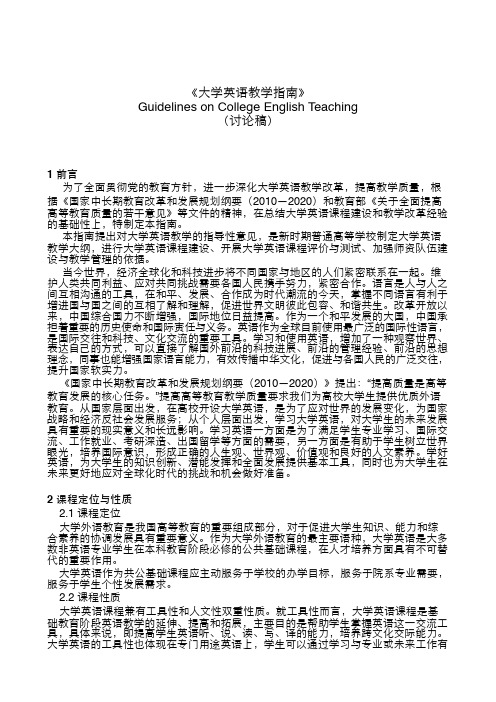
!!!《⼤大学英语教学指南》!Guidelines on College English Teaching!(讨论稿)!!!!1 前⾔言!为了全⾯面贯彻党的教育⽅方针,进⼀一步深化⼤大学英语教学改⾰革,提⾼高教学质量,根据《国家中⻓长期教育改⾰革和发展规划纲要(2010—2020)和教育部《关于全⾯面提⾼高⾼高等教育质量的若干意⻅见》等⽂文件的精神,在总结⼤大学英语课程建设和教学改⾰革经验的基础性上,特制定本指南。
!本指南提出对⼤大学英语教学的指导性意⻅见,是新时期普通⾼高等学校制定⼤大学英语教学⼤大纲,进⾏行⼤大学英语课程建设、开展⼤大学英语课程评价与测试、加强师资队伍建设与教学管理的依据。
!当今世界,经济全球化和科技进步将不同国家与地区的⼈人们紧密联系在⼀一起。
维护⼈人类共同利益、应对共同挑战需要各国⼈人民携⼿手努⼒力,紧密合作。
语⾔言是⼈人与⼈人之间互相沟通的⼯工具,在和平、发展、合作成为时代潮流的今天,掌握不同语⾔言有利于增进国与国之间的互相了解和理解,促进世界⽂文明彼此包容、和谐共⽣生。
改⾰革开放以来,中国综合国⼒力不断增强,国际地位⽇日益提⾼高。
作为⼀一个和平发展的⼤大国,中国承担着重要的历史使命和国际责任与义务。
英语作为全球⺫⽬目前使⽤用最⼲⼴广泛的国际性语⾔言,是国际交往和科技、⽂文化交流的重要⼯工具。
学习和使⽤用英语,增加了⼀一种观察世界、表达⾃自⼰己的⽅方式,可以直接了解国外前沿的科技进展、前沿的管理经验、前沿的思想理念,同事也能增强国家语⾔言能⼒力,有效传播中华⽂文化,促进与各国⼈人民的⼲⼴广泛交往,提升国家软实⼒力。
!《国家中⻓长期教育改⾰革和发展规划纲要(2010—2020)》提出:“提⾼高质量是⾼高等教育发展的核⼼心任务。
”提⾼高⾼高等教育教学质量要求我们为⾼高校⼤大学⽣生提供优质外语教育。
从国家层⾯面出发,在⾼高校开设⼤大学英语,是为了应对世界的发展变化,为国家战略和经济反社会发展服务;从个⼈人层⾯面出发,学习⼤大学英语,对⼤大学⽣生的未来发展具有重要的现实意义和⻓长远影响。
大学英语教学指南(2022版)解读
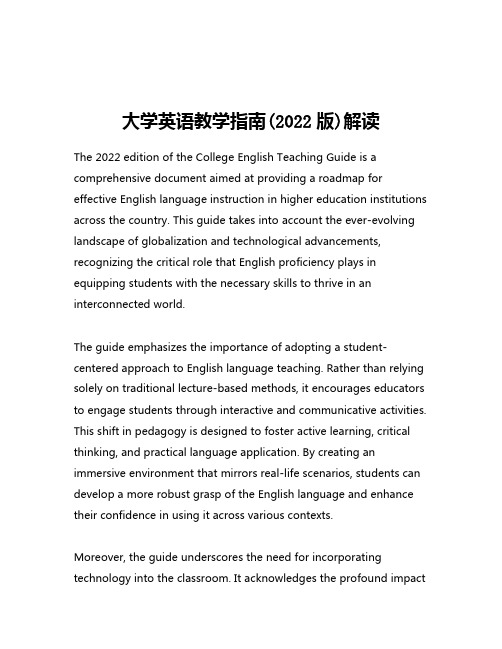
大学英语教学指南(2022版)解读The 2022 edition of the College English Teaching Guide is a comprehensive document aimed at providing a roadmap for effective English language instruction in higher education institutions across the country. This guide takes into account the ever-evolving landscape of globalization and technological advancements, recognizing the critical role that English proficiency plays in equipping students with the necessary skills to thrive in an interconnected world.The guide emphasizes the importance of adopting a student-centered approach to English language teaching. Rather than relying solely on traditional lecture-based methods, it encourages educators to engage students through interactive and communicative activities. This shift in pedagogy is designed to foster active learning, critical thinking, and practical language application. By creating an immersive environment that mirrors real-life scenarios, students can develop a more robust grasp of the English language and enhance their confidence in using it across various contexts.Moreover, the guide underscores the need for incorporating technology into the classroom. It acknowledges the profound impactof digital tools and resources on language learning and advocates for their integration into the curriculum. From online platforms for multimedia materials to collaborative tools for group projects, technology can facilitate personalized learning experiences and cater to diverse learning styles. Additionally, the guide highlights the potential of leveraging virtual exchange programs and international collaboration opportunities, enabling students to engage with native speakers and gain exposure to authentic cultural contexts.Another key aspect of the guide is its emphasis on interdisciplinary connections. English language proficiency is not merely a standalone skill but a crucial component for success across various academic disciplines and professional domains. By fostering cross-curricular connections and promoting the application of English in subject-specific contexts, students can develop the linguistic dexterity required to navigate complex academic discourses and prepare for future careers.Furthermore, the guide recognizes the diversity of learners and advocates for inclusive and differentiated instructional practices. It encourages educators to design learning experiences that cater to diverse learning styles, abilities, and cultural backgrounds. By embracing inclusivity, the guide aims to create an equitable and supportive learning environment where all students can thrive and reach their full potential.Importantly, the guide places a strong emphasis on continuous professional development for English language educators. It acknowledges the rapidly changing landscape of language teaching methodologies, technologies, and research findings. By encouraging ongoing training, workshops, and professional learning communities, the guide seeks to equip educators with the latest pedagogical strategies, tools, and best practices, ensuring that they remain at the forefront of their field.In addition to addressing instructional approaches, the guide also provides guidance on assessment and evaluation methods. It advocates for a balanced approach that combines formative and summative assessments, ensuring that students receive regular feedback and opportunities for improvement. The guide encourages the use of authentic and performance-based assessments that accurately measure students' language proficiency and their ability to apply it in real-world contexts.The 2022 College English Teaching Guide is a comprehensive and forward-looking document that aims to elevate English language education in higher education institutions. By embracing student-centered approaches, technology integration, interdisciplinary connections, inclusive practices, and continuous professional development, the guide paves the way for a more dynamic,engaging, and effective English language learning experience for students across the nation.。
- 1、下载文档前请自行甄别文档内容的完整性,平台不提供额外的编辑、内容补充、找答案等附加服务。
- 2、"仅部分预览"的文档,不可在线预览部分如存在完整性等问题,可反馈申请退款(可完整预览的文档不适用该条件!)。
- 3、如文档侵犯您的权益,请联系客服反馈,我们会尽快为您处理(人工客服工作时间:9:00-18:30)。
《大学英语教学指南》1 前言为了全面贯彻党的教育方针,进一步深化大学英语教学改革,提高教学质量,根据《国家中长期教育改革和发展规划纲要(2010-2020年)》和教育部《关于全面提高高等教育质量的若干意见》等文件的精神,在总结大学英语课程建设和教学改革经验的基础上,特制订本指南。
本指南提出对大学英语教学的指导性意见,是新时期普通高等学校制订大学英语教学大纲,进行大学英语课程建设,开展大学英语课程评价的依据。
当今世界,经济全球化和科技进步将不同国家与地区的人们紧密联系在一起。
英语作为全球目前使用最广泛的语言,是国际交往和科技、文化交流的重要工具。
通过学习和使用英语,可以直接了解国外前沿的科技进展、管理经验和思想理念,学习和了解世界优秀的文化和文明,同时也有助于增强国家语言实力,有效传播中华文化,促进与各国人民的广泛交往,提升国家软实力。
《国家中长期教育改革和发展规划纲要(2010-2020年)》指出:“提高质量是高等教育发展的核心任务。
”提高高等教育教学质量要求我们为高校大学生提供优质外语教育。
高校开设大学英语课程,一方面是满足国家战略需求,为国家改革开放和经济社会发展服务,另一方面,是满足学生专业学习、国际交流、继续深造、工作就业等方面的需要。
大学英语课程对大学生的未来发展具有现实意义和长远影响,学习英语有助于学生树立世界眼光,培养国际意识,提高人文素养,同时为知识创新、潜能发挥和全面发展提供一个基本工具,为迎应全球化时代的挑战和机遇做好准备。
2 课程定位与性质2.1 课程定位大学外语教育是我国高等教育的重要组成部分,对于促进大学生知识、能力和综合素质的协调发展具有重要意义。
大学英语作为大学外语教育的最主要内容,是大多数非英语专业学生在本科教育阶段必修的公共基础课程,在人才培养方面具有不可替代的重要作用。
大学英语课程应根据本科专业类教学质量国家标准,参照本指南进行合理定位,服务于学校的办学目标、院系人才培养的目标和学生个性化发展的需求。
2.2 课程性质大学英语课程是高等学校人文教育的一部分,兼有工具性和人文性双重性质。
就工具性而言,大学英语课程是基础教育阶段英语教学的提升和拓展,主要目的是在高中英语教学的基础上进一步提高学生英语听、说、读、写、译的能力。
大学英语的工具性也体现在专门用途英语上,学生可以通过学习与专业或未来工作有关的学术英语或职业英语,获得在学术或职业领域进行交流的相关能力。
就人文性而言,大学英语课程重要任务之一是进行跨文化教育。
语言是文化的载体,同时也是文化的组成部分,学生学习和掌握英语这一交流工具,除了学习、交流先进的科学技术或专业信息之外,还要了解国外的社会与文化,增进对不同文化的理解、对中外文化异同的意识,培养跨文化交际能力。
人文性的核心是以人为本,弘扬人的价值,注重人的综合素质培养和全面发展。
社会主义核心价值观应有机融入大学英语教学内容。
因此,要充分挖掘大学英语课程丰富的人文内涵,实现工具性和人文性的有机统一。
3 教学目标和教学要求3.1 教学目标大学英语的教学目标是培养学生的英语应用能力,增强跨文化交际意识和交际能力,同时发展自主学习能力,提高综合文化素养,使他们在学习、生活、社会交往和未来工作中能够有效地使用英语,满足国家、社会、学校和个人发展的需要。
根据我国现阶段基础教育、高等教育和社会发展的条件现状,大学英语教学目标分为基础、提高、发展三个等级。
在三级目标体系中,基础目标是针对大多数非英语专业学生的英语学习基本需求确定的,提高目标是针对入学时英语基础较好、英语需求较高的学生确定的,发展目标是根据学校人才培养计划的特殊需要以及部分学有余力学生的多元需求确定的。
大学英语教学与高中英语教学相衔接,各高校可以根据实际需要,自主确定起始层次,自主选择教学目标。
分级目标的安排为课程设置的灵活性和开放性提供了空间,有利于实施满足学校、院系和学生个性化需求的大学英语教学。
3.2 教学要求我国幅员辽阔,各地区、各高校之间情况差异较大,大学英语教学应贯彻分类指导、因材施教的原则,以适应个性化教学的实际需要。
大学英语教学以英语的实际使用为导向,以培养学生的英语应用能力为重点。
英语应用能力是指用英语在学习、生活和未来工作中进行沟通、交流的能力。
大学英语在注重发展学生通用语言能力的同时,应进一步增强其学术英语或职业英语交流能力和跨文化交际能力,以使学生在日常生活、专业学习和职业岗位等不同领域或语境中能够用英语有效地进行交流。
大学英语根据三级教学目标提出三个级别的教学要求。
基础目标的教学要求主要针对英语高考成绩合格的学生,是大部分学生本科毕业时应达到的基本要求。
提高目标和发展目标的教学要求针对大学入学时英语已达到较好水平的学生,也是对学生英语应用能力要求较高的专业所选择的要求。
对英语高考成绩基本合格的学生,学校可适当调整基础目标的部分教学要求。
大学英语三个级别的教学要求分总体描述和单项技能描述。
总体描述包括语言技能与知识、跨文化交际能力和学习策略的要求;单项技能描述则从听、说、读、写、译五个方面对三个等级的教学目标作进一步的说明。
各高校应依据本指南提出的三级教学目标和教学要求,结合学校、院系和学生的实际情况,确定具有本校特色的教学目标和教学要求。
三个级别教学要求的总体能力描述如下:三个级别教学要求的语言单项技能描述如下:上述三个级别的教学目标和教学要求是各高校在制定本校大学英语教学大纲和其他教学文件时的参照基准。
各高校可以根据本校实际情况,对具体要求与指标作适当的调整。
在提倡学生语言技能平衡发展的同时,也鼓励不同学校、不同院系或不同学科的大学英语教学在语言技能的选择上有所侧重,突出特色,以满足院系和学生的不同需求。
4 课程设置4.1 总体框架课程设置是教学目标在学校课程计划中的集中表现,是对课程结构和课程内容所做的安排和规定。
大学英语教学的主要内容可分为通用英语、专门用途英语和跨文化交际三个部分,由此形成相应的三大类课程。
大学英语课程由必修课、限定选修课和任意选修课组成。
各高校应根据学校类型、层次、生源、办学定位、人才培养目标等,遵循语言教学和学习规律,合理安排相应的教学内容和课时,形成反映本校特色、动态开放、科学合理的大学英语课程体系。
课程设置要注意处理好通用英语与专门用途英语、跨文化交际教学的关系,处理好必修课程与选修课程的关系。
课程设置还要充分考虑语言学习的渐进性和持续性,在大学本科学习的不同阶段开设相应的英语课程。
4.2.课程结构与内容4.2.1 通用英语课程通用英语课程是大学英语课程的基本组成部分。
通用英语课程的目的是培养学生英语听、说、读、写、译的语言技能,同时教授英语词汇、语法、篇章及语用等知识,增加学生的社会、文化、科学等基本知识,拓宽国际视野,提升综合文化素养。
通用英语课程分为基础、提高和发展三个级别。
各级别课程相对独立,各有侧重,相互补充。
基础级别的通用英语课程以高中英语选修Ⅰ课程为起点,重点突出听、说、读、写、译基本技能的培养和语言基本知识的学习。
通过一至一年半的英语教学,使学生英语能力达到本指南规定的大学英语教学基础目标的相关要求。
提高级别的通用英语课程强调听、说、读、写、译技能的进一步提升,兼顾语法、词汇、篇章、语用等语言知识的进一步巩固、提高和相关知识的进一步扩充。
通过一年左右的英语教学,使学生英语能力达到本指南规定的大学英语教学提高目标的相关要求。
发展级别的通用英语课程注重学生较高层次语言应用能力的拓展训练,满足具有拔尖创新潜质的高水平学生参与国际学术交流的需要。
通过一至两个学期的英语教学,使学生英语能力等达到本指南规定的大学英语教学发展目标的相关要求。
4.2.2 专门用途英语课程专门用途英语课程以英语使用领域为指向,以增强学生运用英语进行专业和学术交流、从事工作的能力,提升学生学术和职业素养为目的,具体包括学术英语(通用学术英语、专门学术英语)和职业英语两大课程群。
专门用途英语课程将特定的学科内容与语言教学目标相结合,教学活动着重解决学生学科知识学习过程中所遇到的语言问题,以培养与专业相关的英语能力为教学重点。
专门用途英语课程凸显大学英语工具性特征。
各高校应以需求分析为基础,根据学校人才培养规格和学生需要开设体现学校特色的专门用途英语课程,供学生选择;也可在通用英语体系内,纳入通用学术英语和职业英语等内容。
基础级别的专门用途英语课程为基础通用学术英语及入门级职业英语课程,在培养学生语言技能的同时,帮助学生了解和掌握初步的通用学术英语知识以及与专业学习相关的基本英语表达。
提高级别的专门用途英语课程为与专业相关的英语应用能力课程,通过教学,使学生较好地掌握通用学术英语和一定的职业英语知识,培养学生基本达到用英语进行专业交流、从事工作的能力。
发展级别的专门用途英语课程面向学术或职业领域有特殊需求的高水平学生,帮助学生利用英语提高本专业学习、工作的能力,特别是在专业领域用英语进行交流的能力。
4.2.3 跨文化交际课程跨文化交际课程旨在进行跨文化教育,帮助学生了解中外不同的世界观、价值观、思维方式等方面的差异,培养学生的跨文化意识,提高学生社会语言能力和跨文化交际能力。
跨文化交际课程体现了大学英语的人文性特征。
各高校可根据需要开设不同级别的跨文化交际课程,也可在通用英语课程体系内融入跨文化交际的内容。
基础级别的跨文化交际课程以丰富学生中外文化知识,培养学生中外文化差异意识为目的。
可在通用英语课程内容中适当导入一定的中外文化知识,以隐形教学为主要形式,也可独立开设课程,为学生讲授与中西文化相关的基础知识。
提高级别的跨文化交际课程在学生已掌握的语言文化知识基础上开设,主要包括文化类和跨文化交际类课程,帮助学生提升文化和跨文化意识,提高跨文化交际能力。
发展级别的跨文化交际课程旨在通过系统的教学,进一步增强学生的跨文化意识,扩展学生的国际视野,进一步提升学生的语言综合应用能力和跨文化交际能力。
4.2.4 基于教学目标的课程设置各高校大学英语课程设置要照顾到学生的不同起点,充分体现个性化。
既要照顾起点较低的学生,又要给起点较高的学生有发展的空间;既能使学生打下扎实的语言基础,又能培养他们较强的综合应用能力;既要保证学生在整个大学期间的英语语言水平稳步提高,又要有利于学生个性化的学习,以满足他们各自不同的专业和个人发展的需要。
在教学安排上,大学英语起始阶段的通用英语课程若与高中英语选修Ⅰ课程相衔接,选择基础目标,需要144-216课时;对入学时英语基础较好、英语需求较高的学生,可选择提高目标,需要144课时。
与基础目标和提高目标相关的通用英语课程为必修课,每周4课时;与发展目标相关的课程建议以限定选修课形式在大学二年级及以上阶段开设,每周不少于2课时。
